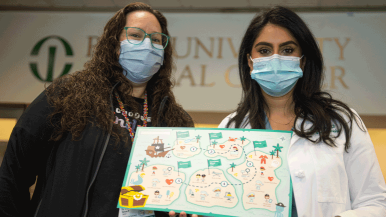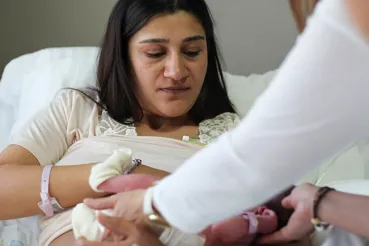Going into surgery is nerve-racking for anyone, but it can be especially frightening for children. Rush University Children’s Hospital has a new tool that is helping Rush’s youngest patients better understand their surgery experience and take on an active role in their care — all while having fun.
The Rush University Children’s Hospital treasure map sets outpatient surgery patients on an interactive treasure hunt to Recovery Island. Upon registration, patients are handed a map that they will follow along with until they complete their journey in recovery. Each island featured on the treasure map shows a step in the outpatient surgical procedure at Rush and gives patients an idea of what and who they can expect to see every step along the way.
Preparing kids for their procedures
At Rush, Child Life Services helps young patients navigate their hospital visit with age-appropriate education, support and preparation for procedures. “We do a lot on the front end as child life specialists to help prepare kids in the spaces that they're currently in,” says Shira Miller, MS, CCLS, manager of child life and creative arts therapies. “However, we didn't have anything that helped them navigate from start to finish what they were going to experience. The treasure map is helping us bridge that gap.”
When kids have an idea of what to expect during their hospital visit in a concrete, tangible way they are better able to cope with the experience. “There is a lot of research in child life that shows that the more prepared a child is, the better they cope with and comply with their care,” Miller says. “Additionally, their anxiety is lowered which results in better outcomes.”
Bringing a vision to life
Behnoosh Shayegan, MD, director of pediatric anesthesiology, first got the idea for a tool like this while completing her anesthesiology fellowship. She witnessed what a difficult and stressful time this could be for children and dreamed of creating something fun and interactive that could help ease the anxiety of patients going through the surgical process. Shayegan teamed up with Miller and the two thought through every stage of a patients’ journey into surgery from the moment they walk through the doors to discharge. The treasure map has been a longtime vision of Shayegan’s. She drew the first iterations of the map by hand and then worked with Rush Marketing Communications to bring her sketch to life.
“I wanted to create an interactive tool that puts the patients themselves in charge of their care,” Shayegan says. “When kids are involved in something that they’re usually scared of, they tend to react more positively.”
Shayegan wanted this to be fun for kids, but also something that served as a guide for parents.
“There’s many different places you have to go throughout the procedure day that it can be very overwhelming,” she says. “The treasure map breaks the experience down into five easy to understand steps that helps everyone understand how long the day is going to be and what you can expect at every stage.”
The road to Recovery Island
As patients make their way through the day of surgery and conquer each island on the treasure map, they get a sticker to mark the completion of another step. When the young explorers finally land at Recovery Island, aka the recovery room, they have reached the treasure and are able to collect a prize from a treasure box which includes small, age-appropriate toys.
Since launching in November, Shayegan and Miller have observed patients and their families enjoying and having fun with the treasure map.
“The kids are really getting a better understanding of all aspects of their care,” Miller says. “It’s also giving us child life specialists and physicians an opportunity to talk more with the patients about what’s happening throughout the day and helping the kids solidify that understanding.”




